Paracanthopterygii
So pretty much Nelson says this group is not appropriately put together but until there is new research with good evidence that says otherwise, he's just going to leave the grouping the say it was in previous publications. Works for me. Technically Paracanthopterygii also includes Batrachiformes and Lophiiformes, but you can find those on the Pediculati page.
Percopsiformes: Trout-Perches
Is it a trout? Is it a perch? Nah brah, it's a trout-perch! There are nine species total, and all are found in freshwater. Each family has its own quirks.

By Ellen Edmonson and Hugh Chrisp (http://pond.dnr.cornell.edu/nyfish/fish.html) [Public domain], via Wikimedia Commons
Percopsidae: Trout-Perches
I would tell the same trout-perch joke but I'm sure you prefer fresher material. If you recall from Salmoniformes, those fishes have an adipose fin. These trout-perches also have adipose fins, which I guess makes them similar enough to warrant borrowing the name.

By Fredlyfish4 (e-mail) [CC BY-SA 3.0], via Wikimedia Commons
Aphredoderidae: Pirate Perch
Puberty is a weird time for humans. Your voice changes, hair appears, and certain parts of the body grow larger...but at least your anus doesn't migrate to your neck! Pirate perch juveniles have the anus located in front of the anal fin. As they age, it migrates forwards towards the head until it is located below the gills. The females insert their heads into holes and use the forwardly-positioned anus to more properly lay their eggs. There is one species, Aphredoderus sayanus.

By National Park Service Digital Image Archives [Public domain], via Wikimedia Commons
Amblyopsidae: Cavefishes
If you quit staring at the amblyopsid's lack of pigmentation, you may notice that it also has rudimentary/absent eyes. These fish are found in caves (hence the name) and as such have no reason to grow costly and expensive eyeballs. The same goes for coloration. The anus is also forwardly-placed, for a similar reason to the Pirate Perch.
Gadiformes: Cods
The cods have pelvic fins that are placed in front of the pectoral fins, giving them the appearance of whiskers.
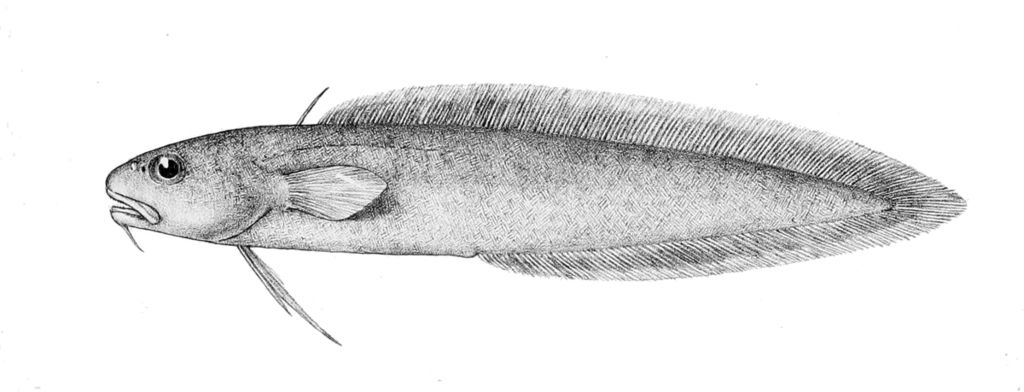
By GM. Woodward (Fishes) [Public domain], via Wikimedia Commons
Muraenolepididae: Eel Cods
There is one genus, Muraenolepis. The body tapers to the tail, with the caudal fin connecting to both the dorsal and anal fins.
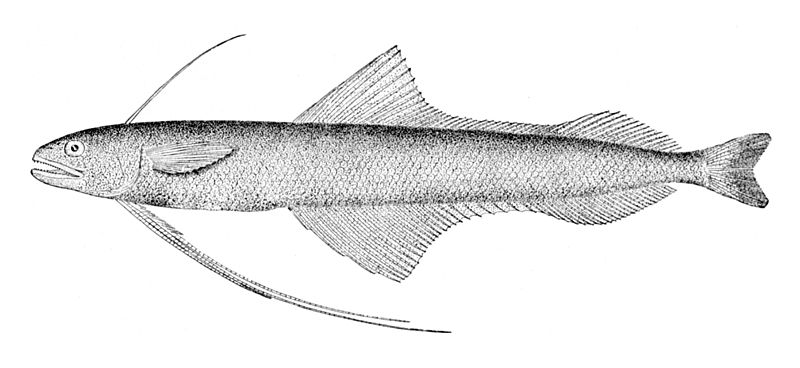
Public Domain
Bregmacerotidae: Codlets
There is one genus, Bregmaceros. These fellas have a fin on the top and bottom that look almost the same, with a notch between the front and back. They also have long skinny pectoral fins and a slender first dorsal fin with one long spine.
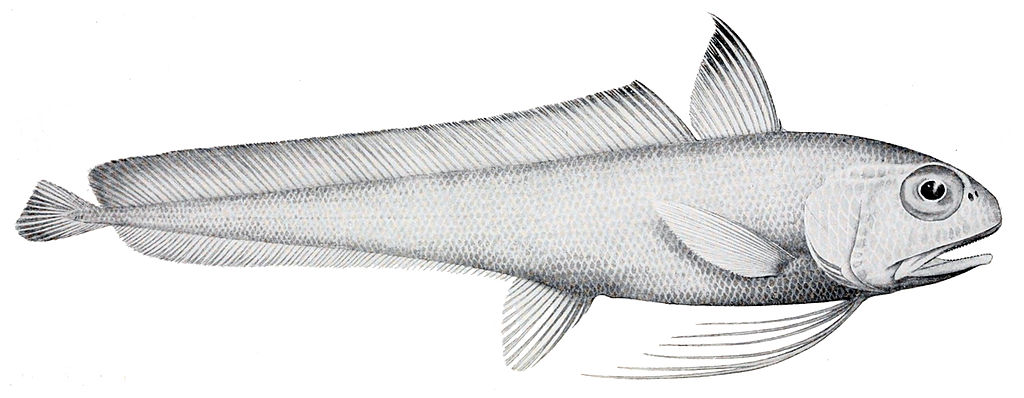
By Alan Riverstone McCulloch (1885-1925) [Public domain], via Wikimedia Commons
Euclichthyidae: Eucla Cod
There is one species, Euclichthys polynemus. The body is tapered like Muraenolepis, but the caudal fin does not connect to the anal or dorsal fins. The first dorsal fin is short (width) but tall and the second is short (height) but long.

By NOAA/MBARI [Public domain], via Wikimedia Commons
Macrouridae: Grenadiers (Rattails)
These fishes have a tapered body and have the caudal fin connected to the anal and dorsal fins. These are very common fishes in the benthopelagic layer, around 200-2000 meters. Some species have developed luminescent organs on their ventral (bottom) side, and many have specialized swim bladder muscles which they use to generate sound.
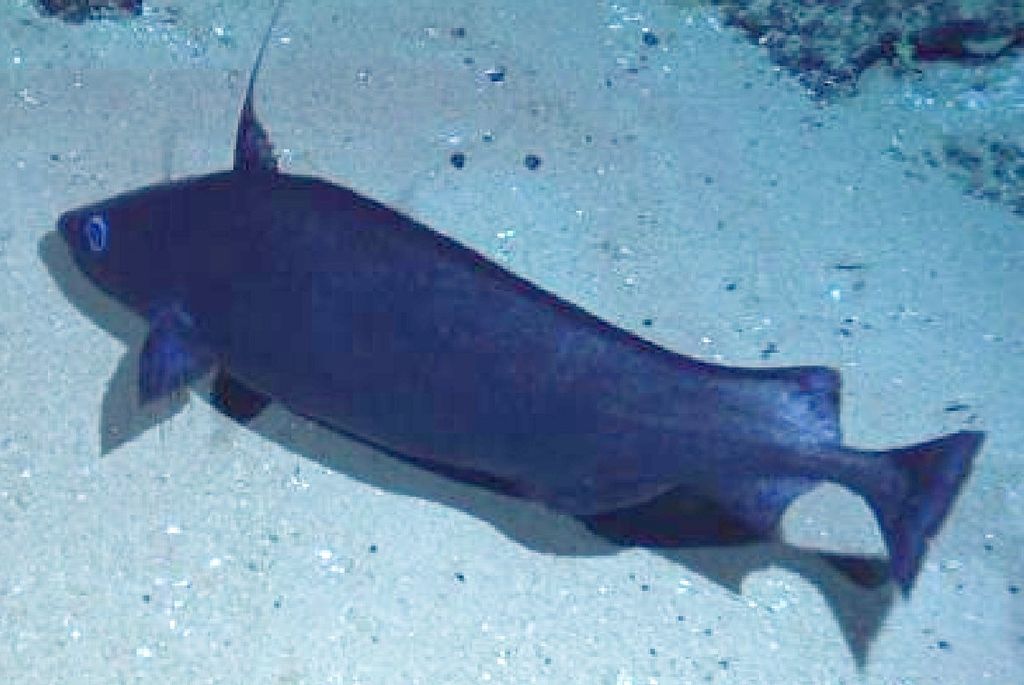
By NOAA Ocean Explorer [Public domain], via Wikimedia Commons
Moridae: Deepsea Cods
These fishes can be distinguished from other cods because the swimbladder is connected to the auditory capsules, known as an otophysic connection. Halargyreus johnsonii is interesting because it has an antitropical distribution. This means it is found at the same latitude in the Northern and Southern hemispheres, but not found between.

Public Domain
Melanonidae: Pelagic Cods
There is one genus, Melanonus. Similar to Moridae, this family lacks the same otophysic connection. It does have the tapered tail with connected fins.
I, Drow male [GFDL (http://www.gnu.org/copyleft/fdl.html) or CC BY-SA 4.0-3.0-2.5-2.0-1.0], via Wikimedia Commons
Merlucciidae: Merluccid Hakes
There's a couple different subfamilies that don't really have a uniting characteristic. One subfamily contains one species, Steindachneria argentea, which has an elaborate luminous organ system on the head and body. This family and the next contain the hakes, which are important food fishes in Europe.
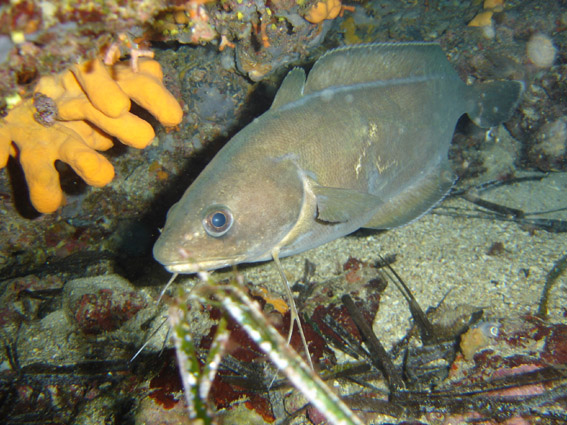
By Elapied at French Wikipedia[CC BY-SA 2.0 fr or CC BY-SA 2.0 fr], via Wikimedia Commons
Phycidae: Phycid Hakes
Another pretty typical cod family. Supposedly the otoliths, stone-like objects in the ear useful for identifying different fishes, are different than the other cods, but I'm not sure how. They just are.
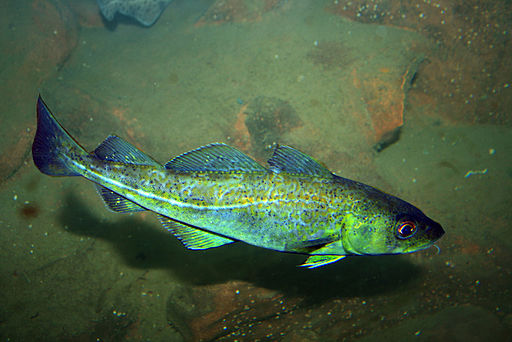
By Peter from Edinburgh, Scotland, UK (Cod Uploaded by Amada44) [CC BY 2.0], via Wikimedia Commons
Gadidae: Cods
This family contains food fishes, such as cods and haddocks. Some species are more recognizable because of their three dorsal fins. One species, Lota lota, is the only freshwater species in Gadiformes. They tend to live in colder areas as they require the decreased temperature for reproduction.
Ophidiiformes: Cusk-Eels
These long slender fishes have super-anterior pelvic fins, usually located near the chin. Like fish whiskers (fishkers?) They also have paired nostrils, on each side!
Ophidioidei
Still long and skinny. The nostrils are pretty high above the upper lip, so that they can keep a stiff upper lip in times of trouble.
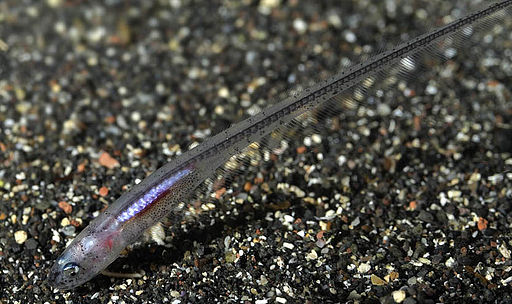
By Etrusko25 (Own work) [CC BY-SA 3.0 or GFDL], via Wikimedia Commons
Carapidae: Pearlfishes
Oh man, these are fun fishes. The larvae have a vexillum, which is a long, threadlike first dorsal fin ray. But that's not the fun part. No, some of these pearlfishes should be called "buttholefishes" because they LIVE IN SEA CUCUMBER BUTTHOLES. Here's the deal: the adult fish literally swims into a sea cucumber's anus and lives inside; there are reports of them feeding off the gills, but Nelson says there is no evidence; in fact they seem to feed off small animals instead. But you can watch it HERE. They have also been known to live commensally (not helping/harming the host) in starfish, clams, and tunicates as well. So next time you go swimming with pearlfishes, watch your anus! You never know who's going to try moving in.
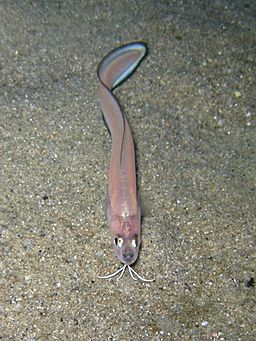
By Roberto Pillon [CC BY 3.0], via Wikimedia Commons
Ophidiidae: Cusk-Eels
Less exciting than the pearlfishes (how can you compete with that?) are the cusk-eels. I have no idea what a cusk is...so don't ask. They have long bodies with a dorsal fin that connects all the way through the caudal to the anal fin. Some species have barbels on the snout or chin, some do not. Their one claim to fame is that the species Abyssobrotula galatheae holds the record for deepest depth for a fish, at 8370m (over 5 miles) in the Puerto Rico trench.
Bythitoidei
Unlike the ophidioids, these fellers have their nostrils much closer to the upper lip. Titillating.

By Williams, J. T.; Carpenter, K. E.; Van Tassell, J. L.; Hoetjes, P.; Toller, W.; Etnoyer, P.; Smith, M. [CC BY 2.5], via Wikimedia Commons
Bythitidae: Viviparous Brotulas
They get their name from the fact that these fishes give birth to live young, but so do all the members of Bythitoidei. Guess they just wanted to sound cool.

By Zugmayer1912_Planche_VI.JPG: Erich Zugmayer (died 1939) derivative work: Haplochromis [Public domain], via Wikimedia Commons
Aphyonidae: Aphyonids
If there was a ophidiiform will, these fishes were left out of it. They didn't get a gasbladder or pyloric caeca, and they don't have scales. They didn't even get fully developed eyes, a fully calcified skeleton, or a catchy common name. However, they do have bilobed ovaries, so I guess they weren't left out in the cold completely.
By original work: Erich Zugmayer (died 1939) derivative work: Haplochromis [Public domain], via Wikimedia Commons
Parabrotulidae: False Brotulas
Poor l'il false brotulas. If the aphyonids were left out of the will, the parabrotulids were booted from the family years ago. As Nelson puts it, "clearly, it is a family without a home." They lack scales, sensory pores and pelvic fins. The lower jaw juts out below the upper jaw, and they too have bilobed ovaries. Hopefully someday this family will find a home where they can feel truly welcome.